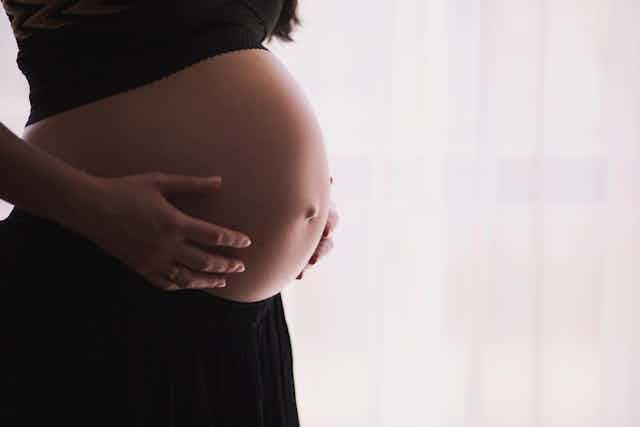My daughter was pregnant, and gave birth, in 2020. She attended every antenatal appointment and scan alone. Her partner sat on a chair on an empty hospital corridor while she was in early labour on the ward. Hers is now a normal experience for women. The COVID-19 pandemic has challenged assumptions about the childbearing year. Some features of this change are very clear. Others will take much longer to see and to understand.
In the UK, the first thing to be impacted in the spring lockdown was where women gave birth. In over a third of areas, home births were suspended at a time when women were looking at giving birth at home as a safer option than hospital. Some women resorted to “freebirthing” – giving birth without any medical professionals present – as a result.
Decisions about whether to continue offering home birth depended on local staffing levels but also local beliefs about the types of care which were vital to maintain. Some areas preserved choices around place of birth, others centralised care in larger maternity units.
There is some anecdotal evidence that more women gave birth at home during the first wave, but also that more opted to have planned caesarean births. Birthing partners – who had gradually been welcomed into labour rooms from the late 1960s – suddenly found themselves shut out on the grounds of safety. Women have been expected to manage antenatal appointments, scans and early labour on their own. Maternal mental health has taken a back seat to physical health: the focus has been on providing a bare minimum of safe service.
The pandemic will affect birth rates, types of care and social beliefs about reproduction in the longer term. Some of these features are not yet clear, but debates about what the experience of pregnancy and birth should look like in the future have been reignited. There will be long term effects on the relationship between midwives and women, with cuts to face-to-face antenatal care. There will also be impacts on both maternal and paternal mental health.
Some of these issues have been the subject of debate for decades. Birth is both a private experience and one on which society has always taken a view. The biology of reproduction does not fundamentally alter but society, medicine and technology affect how birth is experienced.
All change
Prior to the first world war, antenatal care did not exist. Women called for a midwife or their GP when they were in labour and most gave birth at home. Midwives attended over 75% of births, usually working alone.
In the 1920s, antenatal care began to develop in response to growing national concern about rising rates of maternal death in childbirth. The goal was to identify problems before women went into labour, although there was often little that could be done to manage issues. Alongside this, the medical speciality of obstetrics developed in the 1930s to offer emergency care, including instrumental and operative deliveries. Specialists believed that GPs did not have the skill to manage complex situations at home and numbers of babies born in hospital began to creep up in the years prior to the second world war.
Midwives focused on care in uncomplicated situations and their training, which had started in 1905, became longer and more medically focused. Maternal deaths reduced dramatically from the late 1930s, with the development of antibiotics and later with the availability of blood transfusions and improvements in general health. There is little evidence to say that antenatal care or hospital birth had significant impacts.

Nevertheless, medical involvement and antenatal surveillance continued to grow after the second world war and was given momentum with the increasing use of hospitals for birth. Birth in hospital has been justified since the 1960s on the grounds of safety. By 1970, over 80% of births took place in hospitals and a government report called for there to be enough beds for all women to have hospital births.
But the evidence for the greater safety of hospital is weak and has been challenged in the last 20 years. This has meant that home births have continued to be offered to women, but the proportion of women considered “low risk” enough to be eligible for birth outside hospital has got smaller over time. In 2019, only 2.1% of births were at home in England and Wales.
Medicalisation of care
Before the 1960s, women giving birth at home were supported by family, friends and midwives. The move to hospital care meant that they now found themselves alone in cold, clinical hospital rooms. The Association for Improvements in Maternity Services (AIMS) was set up in 1960 following one woman’s experience of hospital birth (she originally called the group “The society for the prevention of cruelty to pregnant women”).
AIMS and other consumer groups such as the National Childbirth Trust (NCT) called for partners to be allowed into labour rooms to offer support to women. More and more hospitals allowed this during the 1970s and since the early 21st century it has become more unusual for partners not to be present. COVID-19 has reminded us that the importance placed on social support and the role of partners is fragile.
Of course, many women welcomed the medicalisation of childbirth – after all, it included effective pain relief in labour, foetal heart rate monitoring and the growing safety of caesarean births. Others, from the 1970s onwards, fought back. Midwives were forced to straddle the different views of birth – believing that it was a normal process, but also being alert to complex and dangerous situations developing.
The COVID-19 pandemic has inevitably forced maternity services to offer support in different ways, with technology playing a central role. Much less attention has been paid to the experiences of women. It remains to be seen whether the pandemic will eventually usher in new and creative ways of providing maternity care – or whether minimal services will become the new normal.

